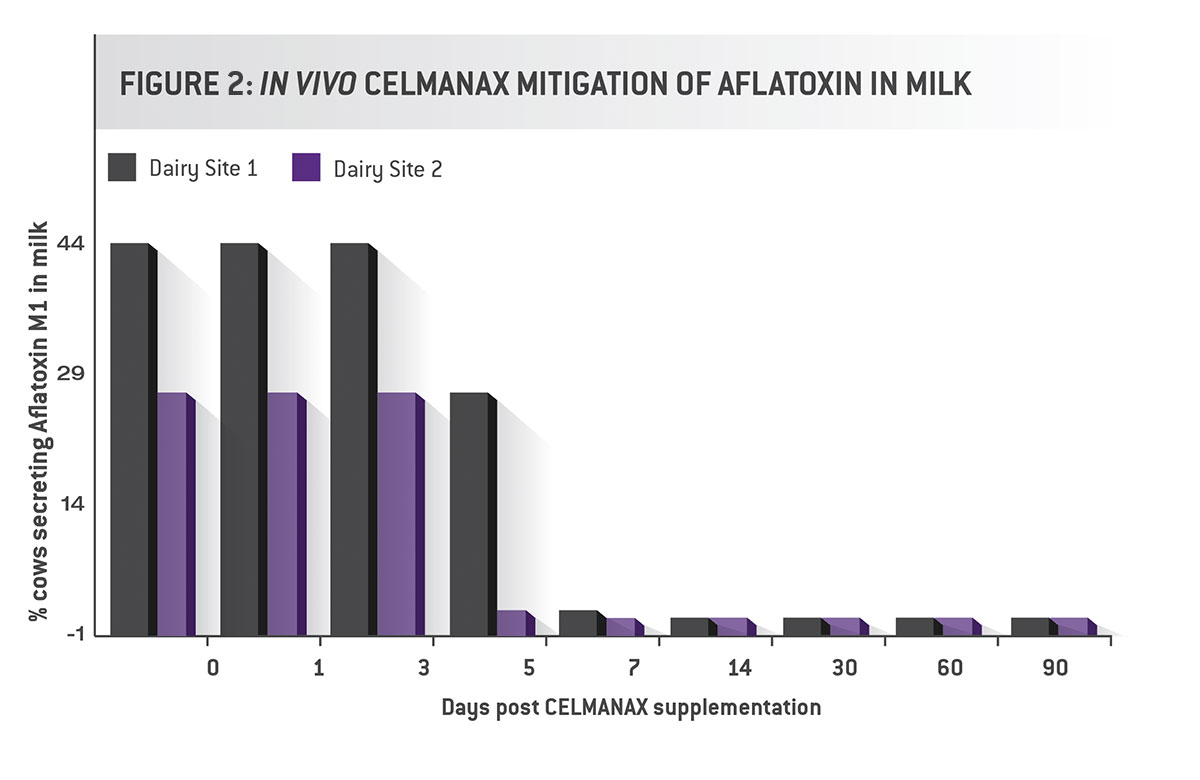
Now’s the time to amp up milk quality.
Regardless of your milk volume goals, producing high quality milk is your ultimate mission as a dairy producer. Somatic cell count (SCC) and protein content affect dairy product flavor, shelf life and cheese yield. And keeping contaminants out of milk is mandatory to meet standards, market expectations and consumer trust.
Many factors affect milk quality, including weather, hygiene, animal genetics and product handling. Diet often plays a critical role as well. Deficiencies in energy or essential nutrients can hamper cows’ resistance to mastitis pathogens. Maintaining the cow’s immune system can help her ward off bacterial challenges that cause high SCC.
One management solution to consider is CELMANAX™ as a feed supplement for your lactating cows. CELMANAX supports the immune system to help cows become more resilient against environmental challenges, including bacteria that impact milk quality. CELMANAX also optimizes digestion and mitigates aflatoxins that can carry over in milk when cows eat contaminated feedstuffs.
Somatic cell count reduction.
Research shows how boosted immunity translates into higher milk quality. In three separate studies (Study 1, Study 2, Study 3), cows fed CELMANAX had numerically lower SCCs compared with control groups without CELMANAX supplementation. (See Figure 1.)

Controlling aflatoxins in milk.
Another milk quality concern is potential carryover of aflatoxin in milk caused by Aspergillus flavus fungus and related species of molds in feed. Although many types of mycotoxins occur commonly in feed, a specific concern for dairy feed is aflatoxin B1, which converts to the metabolite aflatoxin M1 during digestion. Aflatoxin M1 can then transfer to the cow’s milk. At high levels, aflatoxin M1 is toxic to humans and animals.
It’s important to know that threshold limits for aflatoxin M1 in milk vary from country to country. For example, in Europe the maximum aflatoxin M1 content allowed in milk is 50 parts per trillion (ppt), while the U.S. maximum is 500 ppt. Milk with levels exceeding this amount must be discarded. If your lactating cows eat feed containing aflatoxins at 20 parts per billion (ppb) or greater, realize that their milk may exceed the U.S. tolerance level for aflatoxins in milk.
Regardless of the threshold in your area, it’s important to consider the risk of aflatoxin contamination. The levels of feed contamination vary from year to year based on growing conditions, but mycotoxins are almost always present. A 10-year study of mycotoxins in feed, involving 72,821 samples from 100 countries, found that mycotoxin contamination is the rule rather than the exception.
In research at two dairy production sites affected by aflatoxins, feeding CELMANAX helped mitigate aflatoxins carried over in milk. Cows in the study consumed feed contaminated with about 10 ppb of aflatoxin B1. As a result, a significant number of them secreted aflatoxin M1 in their milk—more than 40 percent of the herd at one of the sites.
The study showed that supplementing rations with CELMANAX effectively blocked the transfer of aflatoxin M11 to the milk of cows fed the contaminated feed. Within three to seven days of starting on CELMANAX, the cows in the study no longer secreted aflatoxin M1 in milk. (See Figure 2.)

These RFCs work in synergy to help cows overcome multiple environmental stressors to maintain health and productivity—as well as milk quality. Learn more about the benefits of feeding CELMANAX to dairy cows.
READY TO LEARN MORE?Want to learn more about what our #ScienceHearted team can do for your operation? Fill out the form below and one of our experts will be in touch shortly. |
About Elliot Block |
|
Elliot Block, PhD, serves as Senior Research Fellow & Director of Technology and R&D at Arm & Hammer Animal and Food Production. His responsibilities include managing the global tech services team and using his extensive research background to provide insight on product applications across the globe. |
1 Baines D. Evaluation of prebiotics and probiotics to reduce toxicity of pure and mixed-feed mycotoxins in vitro and to prevent carry-over of aflatoxin B1 in dairy cows. Symposium on Gut Health in Production of Food Animals; Abstracts 202-1 and 202-2. 2014.





